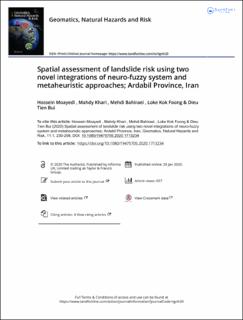| dc.identifier.citation | Moayedi, H., Khari, M., Bahiraei, M., Foong, L. K., & Bui, D. T. (2020). Spatial assessment of landslide risk using two novel integrations of neuro-fuzzy system and metaheuristic approaches; Ardabil Province, Iran. Geomatics, Natural Hazards and Risk, 11(1). | en_US |
| dc.description.abstract | This article addresses the spatial analysis of landslide susceptibility in the Ardabil province of Iran. To this end, two well-known optimization algorithms, namely genetic algorithm (GA) and particle swarm optimization (PSO) are synthesized with an adaptive neuro-fuzzy inference system (ANFIS) to create the ensembles of GA-ANFIS and PSO-ANFIS. Besides, the statistical index (SI) model is also performed to be compared with the mentioned intelligent techniques. Fourteen landslide conditioning factors including elevation, slope aspect, land use, plan curvature, profile curvature, soil type, distance to river, distance to road, distance to fault, rainfall, slope degree, stream power index (SPI), topographic wetness index (TWI), and lithology were considered within the geographic information system (GIS). Out of 253 identified landslides, 177 points (70% of them) were randomly selected and used for the training phase, and the remaining 76 points (30% of them) were used to evaluate the accuracy of the SI, GA-ANFIS, and PSO-ANFIS models. Referring to the calculated area under the receiver operating characteristic curve (AUROC) index, the GA-ANFIS (AUROC = 0.914) and SI (AUROC = 0.821) showed the best performance, respectively in the training and testing phases. Notably, ANFIS-PSO emerged as the faster prediction method compared to the GA-ANFIS. Also, from spatial analysis, it was revealed that around 95%, 87%, and 97% of the training landslides, and 96%, 84%, and 76% of the testing landslides are located in hazardous areas. | en_US |

